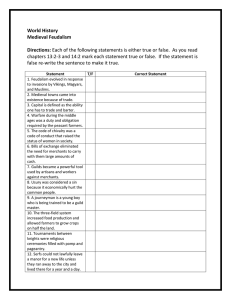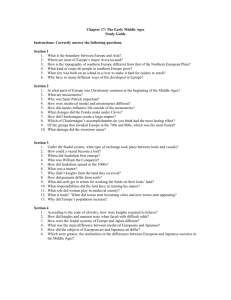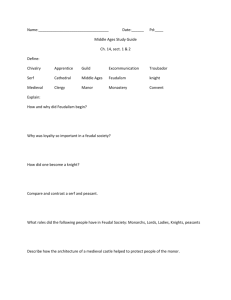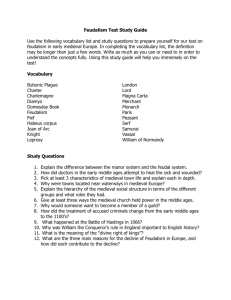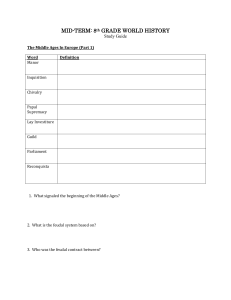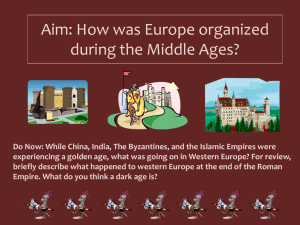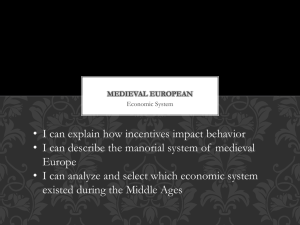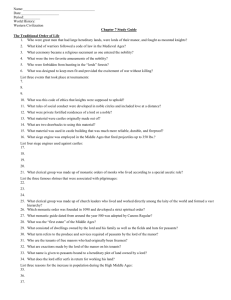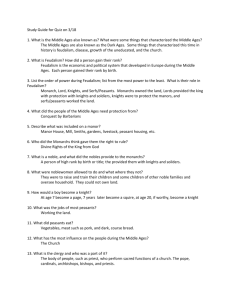DBQ: The European Middle Ages
advertisement
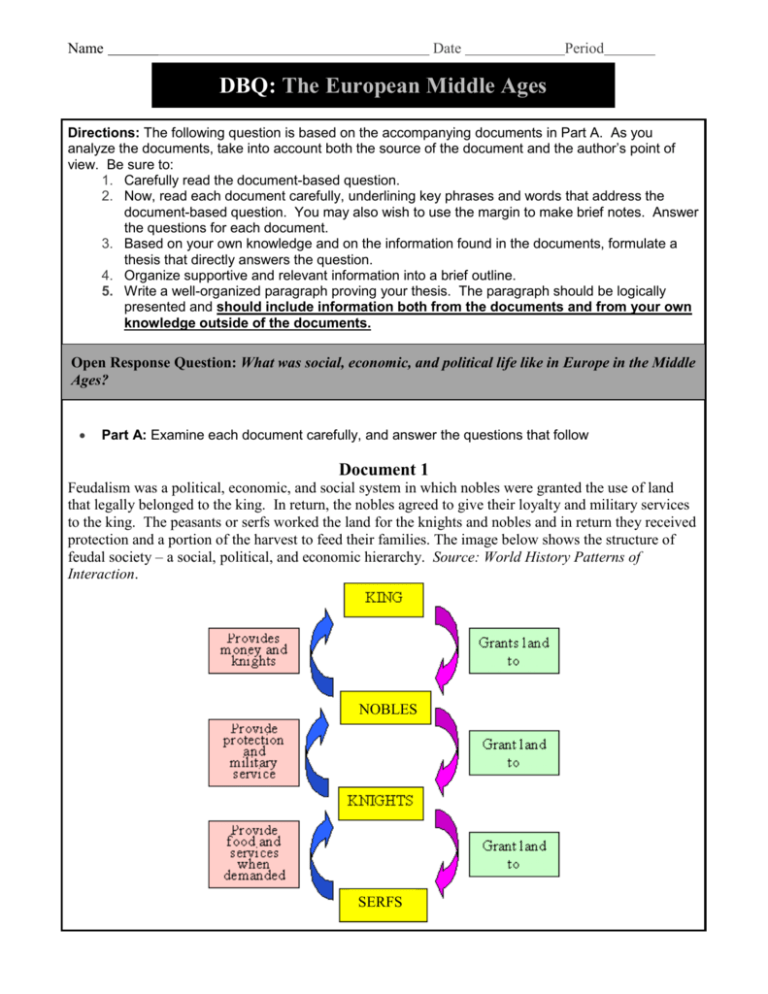
Name Date Period DBQ: The European Middle Ages Directions: The following question is based on the accompanying documents in Part A. As you analyze the documents, take into account both the source of the document and the author’s point of view. Be sure to: 1. Carefully read the document-based question. 2. Now, read each document carefully, underlining key phrases and words that address the document-based question. You may also wish to use the margin to make brief notes. Answer the questions for each document. 3. Based on your own knowledge and on the information found in the documents, formulate a thesis that directly answers the question. 4. Organize supportive and relevant information into a brief outline. 5. Write a well-organized paragraph proving your thesis. The paragraph should be logically presented and should include information both from the documents and from your own knowledge outside of the documents. Open Response Question: What was social, economic, and political life like in Europe in the Middle Ages? Part A: Examine each document carefully, and answer the questions that follow Document 1 Feudalism was a political, economic, and social system in which nobles were granted the use of land that legally belonged to the king. In return, the nobles agreed to give their loyalty and military services to the king. The peasants or serfs worked the land for the knights and nobles and in return they received protection and a portion of the harvest to feed their families. The image below shows the structure of feudal society – a social, political, and economic hierarchy. Source: World History Patterns of Interaction. NOBLES SERFS Document 2 The manor was the economic side of feudalism. The manor was a largely self-sufficient system in which the lord’s land (granted by the king) was farmed by his serfs (essentially slaves bound to the land). The manor included not just farmers, but also artisans who provided for the needs of the manor, a chapel, forest for hunting, and pastureland for farm animals. The two images below show the physical layout of the manor system. For the majority of Europeans, life was hard. Serfs, or peasants obligated to work the lord’s land, had no freedoms. In return for laboring 6 days out of the week, they were granted only one day a week to farm to feed themselves and their families. They also had to pay high rents to the lord’s to use his land. There was no alternative, since peasants needed the lord’s protection from raiding invaders Source: World History Patterns of Interaction, and http://www.uncp.edu/home/rwb/lecture_mid_civ.htm Source: Piers Plowman, in World History Patterns of Interaction Literature Section. Document 3 The role of the Church was very large in Medieval Europe. More than any other institution, it unified Europeans and gave every person a sense of how the world worked. Since political leaders only had local power, the Church was the most powerful institution. This secondary source describes the multiple roles the Church played in the Middle Ages. Source: http://www.mnsu.edu/emuseum/history/ middleages/church.html In a time of great political chaos, the Roman Catholic Church was the single, largest unifying structure in medieval Europe. It touched everyone's life, no matter what their rank or class or where they lived. With the exception of a small number of Jews, everyone in Europe was a Christian during the Middle Ages from the richest king down to the lowest serf. From the moment of its baptism a few days after birth, a child entered into a life of service to God and God's Church. As a child grew, it would be taught basic prayers, would go to church every week barring illness, and would learn of its responsibilities to the Church. Every person was required to live by the Church's laws and to pay heavy taxes to support the Church. In return for this, they were shown the way to everlasting life and happiness after lives that were often short and hard. In addition to collecting taxes, the Church also accepted gifts of all kinds from individuals who wanted special favors or wanted to be certain of a place in heaven. These gifts included land, flocks, crops, and even serfs. This allowed the Church to become very powerful, and it often used this power to influence kings to do as it wanted. Document 4 The map below represents Europe in the later Middle Ages. Europe, although isolated at first, became more connected to the established global trade along the Silk Roads. The increase in trade connecting Europe to places along the Silk Roads was initiated by non-Christian merchants (Jews and Muslimsmany from the Middle East). Jewish merchants were known throughout Europe for bringing luxury goods to the major towns and trade centers of Europe. Due to their wealth, Jews were often persecuted in hard times, especially during the Plague. Source:http://images.google.com/imgres?imgurl=http://web000.greece.k12.ny.us/SocialStudiesResource s/Social_Studies_Resources/GHG_Documents/Trade; Medieval History Sourcebook, “Accounts of the Routes of Jewish Merchants to the East, 847” Document 5 Europe in the Middle Ages was a dangerous place. Invasions from Muslims, Mongols, and other tribal groups were common. War between lords was common. The value of protection and warriors created a social code called Chivalry. Knights fought for lords and ladies and lived by a gentleman-warrior code of Chivalry. The painting below depicts medieval knights. Source: http://www.the-dogs-ofwar.com/Crusades1.jpg Name Date Period Part A-Document Questions: Document 1: a. How did feudalism provide for the security of the people of medieval Europe? Document 2: a. How was manorialism different from feudalism? b. How did medieval farmers deal with the problem of soil exhaustion? Document 3: a. Why would the Church and religious life have had such great appeal at this point in history? Document 4: a. How might increased trade with China and the Middle East have impacted later medieval society which had previously been so isolated? Document 5: a. What does the Code of Chivalry tell us about medieval values in general? (Make some generalizations. DO NOT just repeat what the code says!) Part B-Open Response: Please answer the following question in a well-written paragraph (8-11 sentences): What was social, economic, and political life like in Europe in the Middle Ages?
